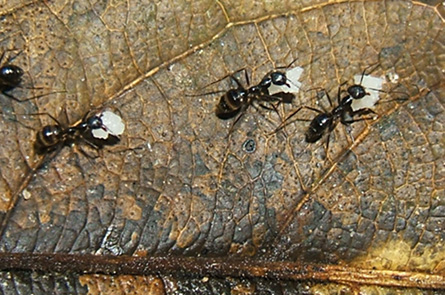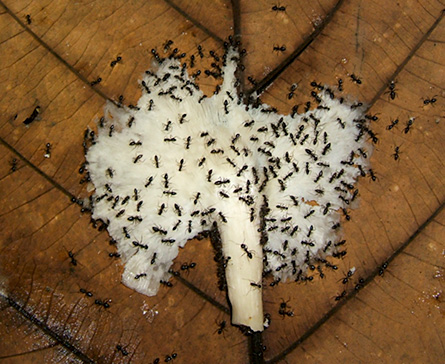Nomadic ants hunt mushrooms
Newly discovered ant lifestyle is one of roaming and picking
No anthills. Just a place to stay for a while, and then it’s off wherever the next mushroom leads.


Colonies of Euprenolepis procera live a lifestyle new to ant science, according to Volker Witte of Ludwig-MaximiliansUniversity in Munich. The ants move nomadically around rainforests at night in Malaysia, hunting and gathering mushrooms.
Such patchy food makes life tricky, but the ants seem to have adapted to the problems, say Witte and Ulrich Maschwitz of Johann-Wolfgang-GoetheUniversity in Frankfurt in an upcoming issue of the journal Naturwissenschaften.
“This is a sensational discovery,” says ant biologist Bert Hölldobler of ArizonaStateUniversity in Tempe.
The nomadic life of this species is different from — in a sense the opposite of — the ways of the fungus-farming attine ants of the Western Hemisphere. The farmer ant lineage invented agriculture millions of years before people did, and today’s 200-plus species construct permanent homes where they tend and eat spongy masses of interlocking threads of fungus.
These masses are nonreproductive tissue, the mycelium that makes up most of a fungus and typically remains hidden in the soil, a log, a molding bread slice. A particular farm grows just one type of fungus, often one that sprouts nubbins that make nutritious ant snacks.
The Malaysian ants aren’t farmers, but hunter-gatherers. They don’t have a special fungus buddy-species, and they don’t bother with thready masses. Instead the harvester ants target the reproductive structures, such as the fleshy little umbrellas that open from the ground after a rain and make spores.
The newly discovered harvesters aren’t related to the farmers, Hölldobler says. “It might very well be that ancestral attines gathered fungi before they became fungus cultivators.”
“One of the coolest things about this paper is that it may provide clues to the evolutionary precursors of fungus-growing,” says Ted Schultz of the Smithsonian Institution in Washington, D.C. “This is a great paper.”
Ants have diversified into societies with elaborate specialties: slave-raiding other ant colonies, doing bodyguard duty for plants, sweeping through forests in “armies” of pillagers, tending herds of plant-sucking insects. Nevertheless, Witte says, ant biologists have not seen it all.
Before Witte began studying E. procera in 2006, biologists knew virtually nothing about the ants’ biology. For a basic test to see if the ants had any special interest in fungi, Witte dotted the forest with dozens of fresh mushrooms from a market. Within 4 hours, these ants had found and swarmed over 44 percent of the windfalls. Nibble by nibble, the ants typically dismantled and carried away almost three-quarters of a mushroom within 4 hours. Twenty-four hours later, the mushroom was gone.
To test the ants’ preferences, Witte picked some 80 kinds of mushrooms from around the forest and set them in the middle of columns of ants out foraging. The ants ignored many offerings but swarmed to break up and take home 30 of the species, clearly more adventurous eaters than the fungus farmers.
Looking for nests, Witte backtracked along columns of foragers. Ants didn’t dig their own homes. Colonies with as many as 20,000 members sheltered in some nook among tree roots or in gaps within the leaf litter. Within days the colonies moved on, carrying everything with them, including their eggs and larvae.
The researchers transplanted some (of the smaller) ant colonies into the lab and found that harvesters pile their crumbs in little heaps in their shelters. The ants then process the haul, gathering around to chew and regurgitate what will eventually feed the colony.
The processed mound of soft, dark pulp exudes a “sweetish-sourish smell,” Witte says. “I wouldn’t eat it, but it doesn’t smell bad.” Something about the chewing seems to prolong the shelf life of the fungi, he says.
I
n the lab, the researchers discovered that the ants will also eat a dead cricket if given a chance. That’s probably not a chance they often get in the wild, Witte says. He hasn’t seen much take-down power among the ants. When he fed colonies nothing but mushrooms for months, the ants thrived.Living in a rainforest could give the ants their best shot at finding year-round mushrooms in a moist environment. For seasons there, “the difference is between rain and a lot of rain,” Witte says.
Rainforests also crawl with ants, so competition gets fierce for ant food, he says. The rare skills of mushroom harvesting open up a new lunch basket.
Mushroom eating could make the ants an overlooked player in forest dynamics, Witte says. Carrying around the mushrooms might distribute the spores and may influence the spread of plants that need mushroom partners to thrive.
Mushroom-eating ants could be overlooked, period, says Cameron Currie of the University of Wisconsin–Madison. Hearing about the paper reminded him of ants he’s seen scurrying over mushrooms in the Western Hemisphere but didn’t take time to follow around. Maybe, he says, there are more mushroom nomads.






